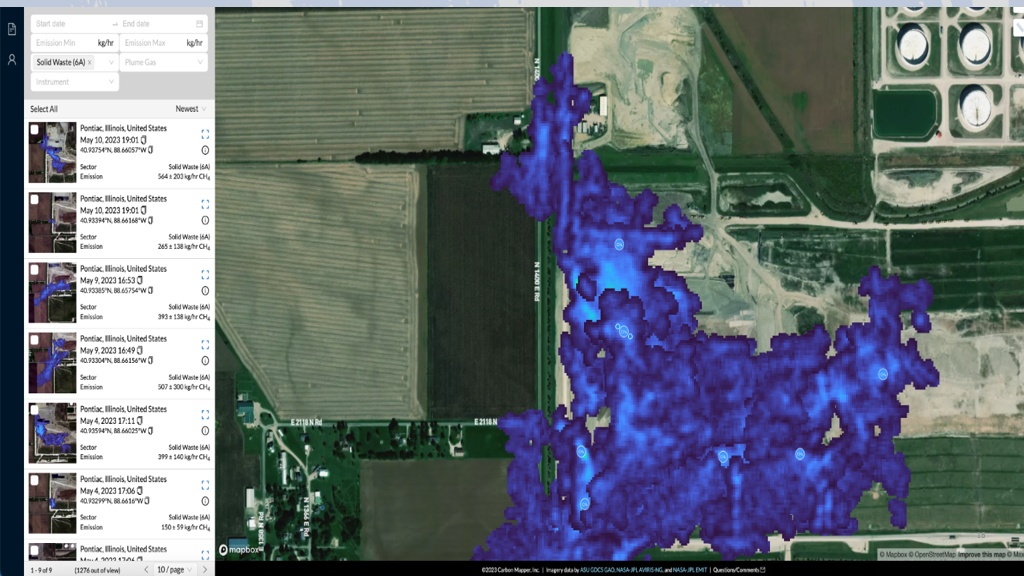
The Future of Landfills: How Innovation is Reducing Emissions and Capturing Value
March 25, 2025
In partnership with Industrious Labs and RMI, MiSBF hosted a webinar and panel discussion, The Hidden Cost of Landfills: Tackling Methane Emissions for a Sustainable Future, to explore new research and technological developments that address the challenges of methane reduction in Michigan’s landfills.
Landfill Methane: An Urgent Environmental Challenge
Michigan is the sixth state in the country with the most methane emissions from landfills – 11 million metric tons in CO2 equivalent. In addition to being a potent greenhouse gas that has more than 80 times the warming power of CO2, methane drives air and water quality problems that disproportionately impact BIPOC and low-income communities.
According to research by Industrious Labs presented by their Circular Economy Director, Katherine Blauvelt, methane emissions from landfills are higher than currently estimated and the regulations in place aren’t enough to effectively capture methane capture and protect communities.
>> See the Industrious Labs’ US Landfill Emissions Map here.
The good news is that recent technological innovations allow landfill operators to improve the detection and capture of methane emissions, which could lead to a 56% reduction in emissions through 2050.
Carbon Mapper
Carbon Mapper uses a type of passive remote sensing that looks for signals of methane in the sun’s rays bouncing off the earth’s surface. Imaging spectrometers identify methane point sources which can then be visualized to estimate the source’s location and concentration.
The tool is used to identify the highest-emitting facilities, monitor and verify reductions, and guide our understanding of how emissions are reported.
>> See Carbon Mappers’ public data portal.
If you are concerned about a particular site monitored by Carbon Mapper, reach out to their team at info@carbonmapper.org.
Bridger Photonics
Bridger Photonics uses an active remote sensing technology called Gas Mapping LiDAR to identify, quantify, and track emissions on oil and gas infrastructure as well as landfills.
Data is collected by high-speed low-flying aircraft equipped with sensors that can cover an entire landfill in a matter of minutes. Censors produce actionable data for facilities, precisely quantifying point sources. This helps facility managers prioritize issues and track progress toward emissions reductions.
>> Learn more about Gas Mapping LiDAR™ on the Bridger Photonics website.
Sniffer Robotics
Michigan’s own Sniffer Robotics has developed a new way for landfill operators to avoid the costly, time-consuming and dangerous “walking surveys” typically used for compliance monitoring.
The system uses drones to drag nozzles on the ground to collect data without the interference of bias and errors caused by human error. Facility managers can then use the data collected to prioritize specific areas for better methane capture.
Sniffer Robotics’ technology has been approved by the EPA and operates on 100 landfills today.
>> See the SnifferDRONE™ in action.
LoCi Controls
LoCi Controls develops advanced gas collection and control technology using sensors on individual gas wells. According to federal regulation, wells only need to be visited once per month for monitoring, but operational and environmental changes can cause changes in emissions on a daily basis.
LoCi’s WellWatcher® analytics system provides real-time data and insights to identify problems quickly so landfill operators can address them immediately and limit the time their personnel have to spend on the landfill. Facilities using LoCi’s system increase landfill gas capture by 10-20%, reducing emissions by the same amount.
>> Learn more about how the LoCi Control System works.
A Proactive Approach to Landfill Methane Capture
The technologies presented offer significant benefits to landfill operators, communities, and regulators:
- Maximized methane capture transforms the super-pollutant into a valuable energy resource.
- Reduced odors make noticeable improvements on nearby neighborhoods.
- Improved monitoring ensures compliance, reducing the risk of costly violations.
- Remote sensing technologies reduce the time landfill workers have to spend on landfill terrain, improving health and safety conditions.
In combination, these solutions are helping landfill operators transition from a reactive to proactive approach – instead of waiting for leaks to be detected, operators can actively manage and prevent emissions.
By embracing these innovations, Michigan can take meaningful steps toward a cleaner and healthier future.
We would like to thank our partners and presenters for taking the time to make this information available to the sustainability community in Michigan:
- Katherine Blauvelt, Circular Economy Director, Industrious Labs
- Tom Frankiewicz, RMI (panel moderator)
- Tia Scarpelli, Carbon Mapper
- David Barron, Sniffer Robotics
- Mike Thorpe, Bridger Photonics
- Nicole Neff, LoCI Controls
For more detail, watch the event recording here on YouTube.
>> Check out more upcoming events highlighting sustainability issues and initiatives in Michigan.
Don’t forget, diverting food waste from landfills is the most effective long-term solution for cutting methane emissions. Read our Michigan Food Waste Roadmap to learn more.
